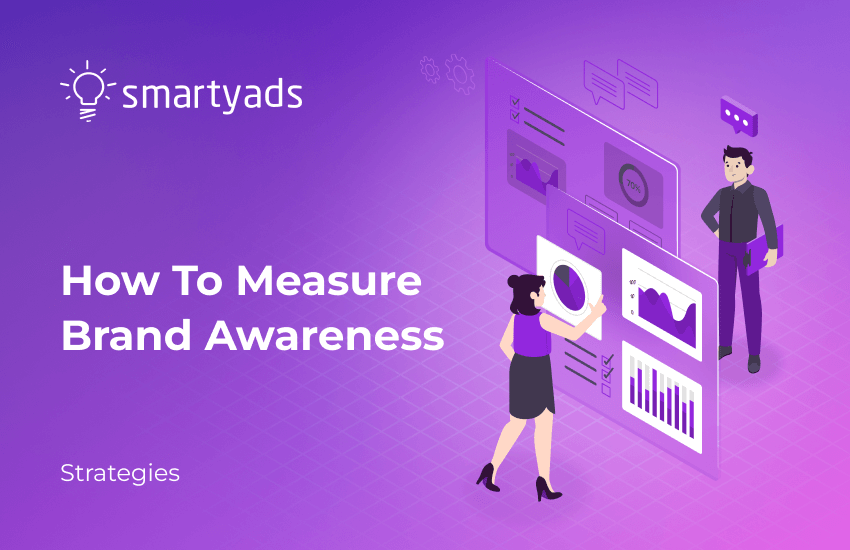Brand trust plays a crucial role in consumer decision-making, with a significant 81% of consumers acknowledging that it can be the ultimate determining factor in whether they choose to take a desired action or reject it. This statistic highlights the paramount importance of establishing and nurturing trust in today's competitive marketplace. Consumers are increasingly mindful of aligning themselves with brands they perceive as reliable, ethical, and authentic, making trust a key driver of customer loyalty, advocacy, and, ultimately, business success.
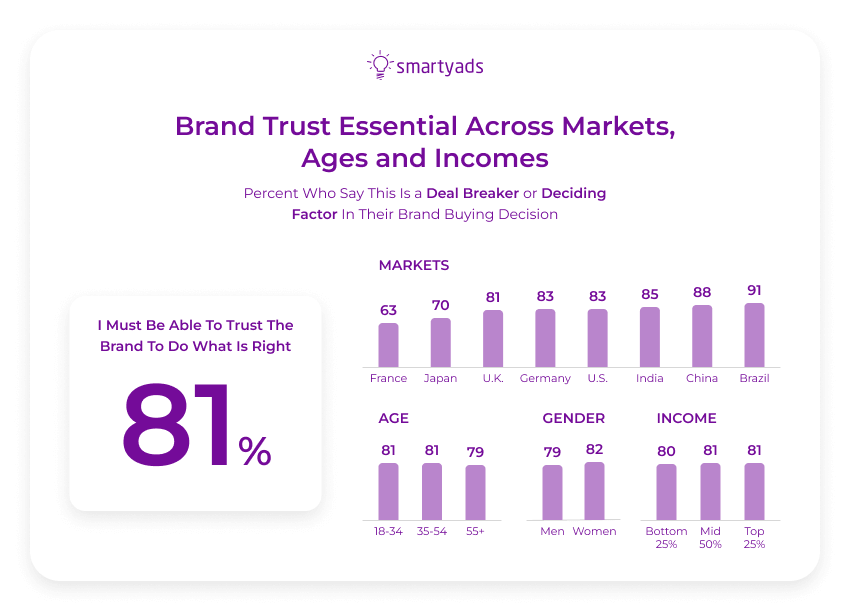
Often considered an elusive and intangible concept, brand awareness has become increasingly measurable in the modern business landscape. While it may initially appear abstract, businesses now have access to a range of tools and methodologies that allow them to quantify and track brand awareness with greater precision.
Through robust data analytics, surveys, social media monitoring, website analytics, and other brand awareness research techniques, companies can gather valuable insights into how their brand is recognized, recalled, and resonated with their target audience. This enhanced measurability empowers businesses to make informed decisions, optimize marketing strategies, and gauge the effectiveness of their brand awareness efforts.
By understanding the tangible impact of brand awareness, organizations can allocate resources more effectively, foster stronger customer connections, and ultimately achieve their growth objectives.
However, let's look at it one by one.
What is brand awareness?
Brand awareness refers to the level of familiarity and recognition your target audience has with your brand. It represents the extent to which consumers are aware of your brand's existence, name, logo, products, and overall identity.
Measuring brand awareness involves assessing factors such as your brand's recall, recognition, and associations. It is crucial to building brand equity and fundamental in shaping consumer perceptions, purchase decisions, and overall loyalty toward your brand.
Why measuring brand awareness metrics is important?
Measuring brand awareness is crucial for your business as it offers a multitude of benefits. By evaluating the level of recognition and familiarity your target audience has with your brand, you gain valuable insights for strategic decision-making.
Understanding how effectively your marketing efforts generate brand visibility helps you gauge your brand's position in the market and identify areas for improvement or differentiation compared to your competitors.
Moreover, measuring brand awareness allows you to assess the effectiveness of your marketing campaigns and channels, enabling you to optimize your strategies and allocate resources more efficiently.
By monitoring brand awareness, you can strengthen brand equity, as a well-known and recognized brand tends to command higher value, customer loyalty, and trust.
Furthermore, brand awareness measurement helps you identify specific segments or regions where your brand has higher or lower awareness, facilitating targeted marketing efforts and customization of messages.
Ultimately, measuring brand awareness empowers you to make informed decisions, drive business growth, and establish a strong and influential brand presence in the market.
How to measure brand awareness? 8 important brand awareness metrics
Measuring the success of brand awareness campaigns is a multifaceted and dynamic process that requires careful consideration of various factors. The effectiveness of brand awareness measurement techniques largely depends on the specific marketing channel used for your campaign, as well as the methods you currently employ to measure your marketing goals. However, within this context, several general approaches can be employed to decode the right brand awareness metrics and effectively measure brand awareness.
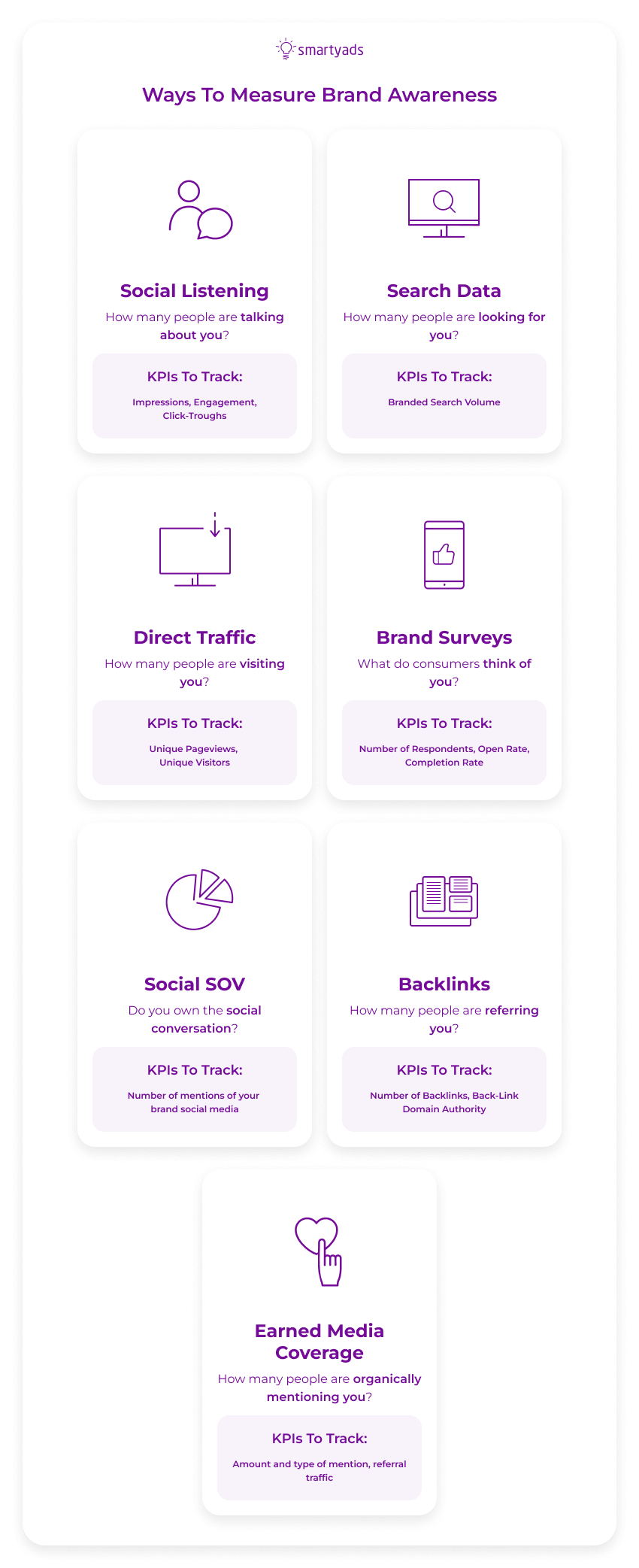
1. Brand awareness surveys and questionnaires
Implementing a brand awareness survey or questionnaire among your audience can provide valuable insights into their awareness and perception of your brand. By asking specific questions related to brand recall, recognition, and associations, you can gather qualitative and quantitative data to assess brand awareness levels. Consider incorporating open-ended questions to capture nuanced feedback and uncover deeper insights.
Brand awareness surveys are different and have various purposes:
Product recognition: How familiar are consumers with your product?
Product recall: How easily does your product come to mind when thinking about its category or type?
Product perception: What do people think of when they hear your product name?
Product identity: How do consumers perceive your product based on their experiences?
It's also beneficial to ask a combination of aided and unaided brand awareness questions to gain a deeper understanding of the impact your product has.
Unaided question example: What product comes to mind when you think of smartphones?
Aided question example: Which of the following smartphone brands are you aware of (check all that apply)? Apple, Samsung, Google, OnePlus.
2. Social media engagement
Monitoring social media platforms is essential for understanding the impact of your brand in the digital realm. A significant majority of consumers, amounting to 77%, express a preference for engaging in shopping activities with brands that they actively follow on social media.
By analyzing metrics such as mentions, shares, likes, comments, follower growth, and engagement rates, you can gauge the reach and effectiveness of your brand awareness efforts in the social media sphere. Additionally, sentiment analysis can help assess the overall sentiment surrounding your brand and identify potential areas for improvement.
3. Website analytics
Examining website traffic data provides valuable insights into brand awareness generated online. Analyzing metrics such as unique visitors, referral sources, time spent on the site, page views, and bounce rates helps measure the level of interest and awareness your brand generates among website visitors. It is also useful to track specific landing pages and monitor user behavior to determine the effectiveness of various online touchpoints in driving brand awareness.
The recorded figures for direct traffic are typically lower than other traffic measurements, but that shouldn't be a concern. What holds the utmost importance is the change in direct traffic over time. An upward trend in direct traffic signifies growth in your brand's presence.
Here's how you can measure it:
Utilize tools like Google Analytics or similar platforms to track specific direct traffic metrics, such as unique pageviews and direct blog referral sources. Monitor these numbers on a month-over-month basis to gain insights into the evolution of your brand awareness over time.
4. Branded search volume and keyword analysis
Tools like Google Trends and keyword research tools can be utilized to assess the branded search volume for your brand name and related keywords. Higher branded search volume indicates brand awareness growth and interest. Analyzing keyword performance and search trends can provide valuable insights into your brand's visibility in search engine results and identify emerging trends or topics that align with your brand.
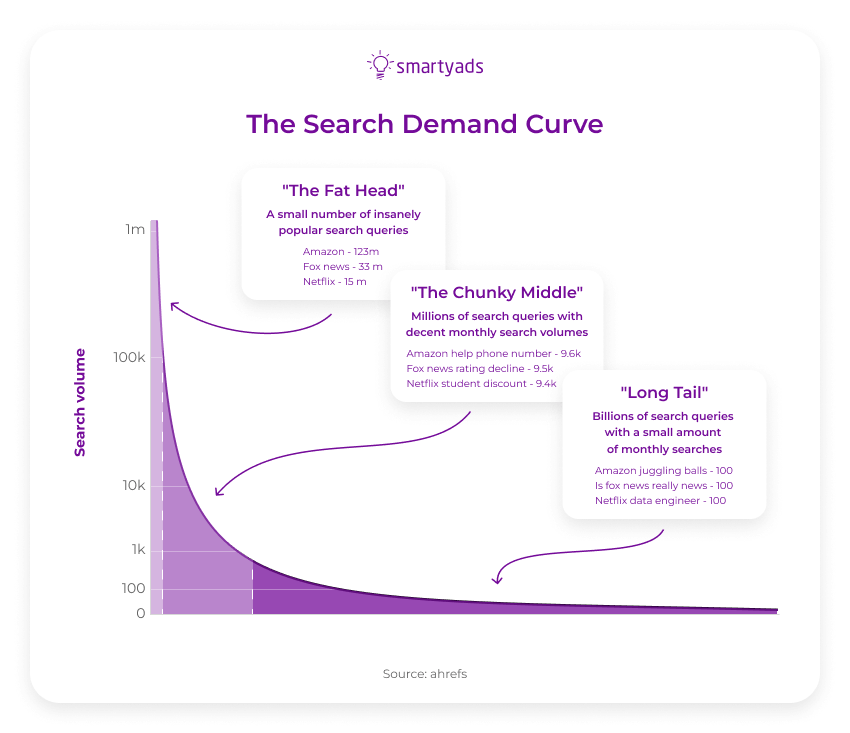
To measure brand visibility, utilize SEO tools like Ahrefs, Semrush, and Moz. These tools provide valuable insights into branded search volume and keyword analysis. For example, Ahrefs allows you to determine the monthly search volume for your brand name, indicating its online visibility. Additionally, these tools offer data on searcher demographics, such as geographic location and device usage, helping you understand your audience better.
By leveraging these insights, you can tailor your brand awareness strategies, optimize your website, and track changes in brand visibility over time.
5. Media monitoring and PR analysis
Tracking media coverage on social media platforms, press releases, and brand mentions in both online and offline channels allows you to assess the volume and sentiment of media mentions. This information helps you gauge brand visibility, reputation, and perception among the wider audience. Monitoring industry publications, news outlets, and social media discussions can help identify opportunities for brand exposure and gauge the impact of your public relations efforts.
Don't forget that standing out from the competition requires a clear and creative brand awareness strategy. However, don't try to base it on making fun of your competitors because two-thirds of consumers find this approach annoying.
There are a lot of services for measuring these metrics. We have collected several of them:
Meltwater
Meltwater provides comprehensive media monitoring and PR analytics, allowing you to track mentions, monitor social media, analyze sentiment, and measure the impact of your PR efforts.
Cision
Cision offers media monitoring and PR analysis tools to help you track media coverage, identify influencers, measure the reach and impact of your brand recognition campaigns, and generate detailed reports.
Brandwatch
Brandwatch is a social listening tool that enables media monitoring and PR analysis. It allows you to monitor mentions across various social media platforms, track sentiment, identify trends, and gain insights into your brand's online reputation.
Talkwalker
Talkwalker offers media monitoring and PR analytics solutions to track brand mentions, monitor news articles, analyze social media conversations, and measure the impact of your PR campaigns.
Mention
Mention is a media monitoring tool that helps you track brand mentions across the web, social media, and news outlets. It provides real-time alerts, sentiment analysis, and competitive benchmarking.
6. Brand tracking studies
Implementing periodic brand tracking studies provides a comprehensive analysis of brand awareness and other key brand metrics over time. These studies typically involve a combination of brand awareness surveys, focus groups, and data analysis to measure brand perception, loyalty, market position, and brand equity. By tracking changes in brand awareness metrics over time, you can identify trends, evaluate the impact of specific marketing initiatives, and make data-driven decisions to further enhance brand recognition and perception.
It is important to note that the specific measurement methods and techniques employed may vary based on the nature of your marketing channels, objectives, target audience, and industry. Thus, it is crucial to continuously evaluate and refine your measurement approach to effectively evaluate the success of your brand awareness initiatives and make data-driven decisions that align with your overall marketing strategy.
7. Earned media coverage
Earned media coverage, also known as third-party publicity, encompasses brand mentions or references obtained organically, typically in the form of blog posts or social media content. This type of media holds immense significance due to its ability to provide unbiased reviews from individuals who have genuinely experienced your product or service. As such, it carries a higher level of trustworthiness than sponsored reviews, and the best part is that it comes at no monetary cost.
It is advisable to leverage social listening tools or brand-tracking software to gauge the impact of earned media. By monitoring the frequency of unprompted online mentions, you can gain valuable insights into the visibility and resonance of your brand across various platforms. This practice becomes particularly insightful during major marketing campaigns, allowing you to assess the campaign's reach and impact across different channels.
The utilization of a social listening tool enables you to capture and analyze brand mentions that occur organically in real time. Social listening ensures you don't miss out on valuable feedback, discussions, or conversations surrounding your brand. By actively tracking these unprompted mentions, you gain a deeper understanding of how your target audience perceives and interacts with your brand. Furthermore, social listening provides an opportunity to identify brand advocates, influential voices, and potential brand ambassadors who can further amplify your message and expand your reach.
In addition to monitoring the frequency of brand mentions, it is equally important to assess the sentiment and context in which your brand is being discussed. Analyzing the tone of these mentions, whether positive, negative, or neutral, allows you to gauge the overall sentiment surrounding your brand. This information helps you identify areas of improvement, address customer concerns, and capitalize on positive feedback.
Moreover, social listening provides valuable insights into the specific aspects of your product or service that resonate most with your customers. By understanding what captures their attention and generates discussions, you can refine your marketing strategies, tailor your messaging, and enhance customer experiences accordingly.
By actively monitoring earned media coverage, you unlock a wealth of actionable insights that can guide your brand's future endeavors. It enables you to stay connected with your audience, adapt to their needs, and build brand awareness based on trust and credibility. Ultimately, leveraging earned media as a strategic advantage empowers your brand to thrive in a digitally connected world where authentic experiences and unbiased opinions hold significant sway.
8. Backlink Profiles
Backlinks, which are links from other domains pointing to your website, hold valuable insights into your brand's online presence. Utilizing a free backlink checker tool can uncover these links and gain a deeper understanding of your brand's popularity and reach.
The quantity of backlinks your site receives indicates brand awareness, showcasing how many other websites deem your content valuable enough to link to. However, it's not just about the quantity; the sources' quality and diversity also matter. Backlinks from reputable publications, industry leaders, and authoritative websites are strong indicators of a robust brand presence. These endorsements from trusted sources can significantly boost your brand's credibility and visibility.
Furthermore, analyzing the sources of your backlinks can provide insights into the specific areas where your brand resonates the most. If you receive a significant number of backlinks from industry-specific blog posts, your brand appeals to a particular demographic or niche within your industry. This knowledge can help you tailor your marketing efforts to better target and engage with the audience that is most interested in your business.
By understanding your backlink profile, you can refine your brand awareness strategies, identify potential partnership opportunities, and uncover new avenues for getting referral traffic. Regularly monitoring and analyzing your backlinks allows you to track the impact of your content and brand awareness efforts, helping you make informed decisions to improve your brand's online visibility and authority.
How to measure brand awareness without using many different tools?
The multitude of metrics through which you can track brand awareness can make your head spin. And using different tools to measure brand awareness can be difficult and irrational, so you're probably wondering how to do it easier and faster.
And the answer is: using the DSP.
Here's a simple guide on how to do it:
Define KPIs for your Brand Awareness Campaigns
Determine which metrics align with your brand awareness goals. Examples include impressions, reach, frequency, viewability, and engagement metrics like clicks or interactions.
Set up Tracking and Attribution
Ensure proper tracking mechanisms are in place to accurately measure brand awareness with the selected KPIs. Implement tracking pixels or tags the DSP provides to monitor ad impressions, clicks, and conversions.
Utilize Audience Segmentation
Leverage the targeting options within the DSP to reach your desired audience segments. By reaching the right people, you can increase the likelihood of building brand awareness among your target market.
Monitor Reach and Frequency
Track the number of unique users exposed to your ads (reach) and how often they are exposed (frequency). This helps assess the level of brand exposure and ensure that it aligns with your campaign objectives.
Analyze Engagement Metrics
Evaluate user interactions with your ads, such as clicks, conversions, or other engagement metrics provided by the DSP. This helps gauge the effectiveness of your messaging and creative in capturing the audience's attention.
Conduct Brand Lift Studies
Partner with the DSP or third-party vendors to conduct brand lift studies. These studies measure the impact of your advertising on brand awareness metrics like brand recall, recognition, and perception, providing a more holistic view of brand awareness.
Compare Pre and Post-Campaign Awareness
Compare brand awareness metrics before and after running your campaign to assess the uplift and effectiveness of your DSP advertising efforts.
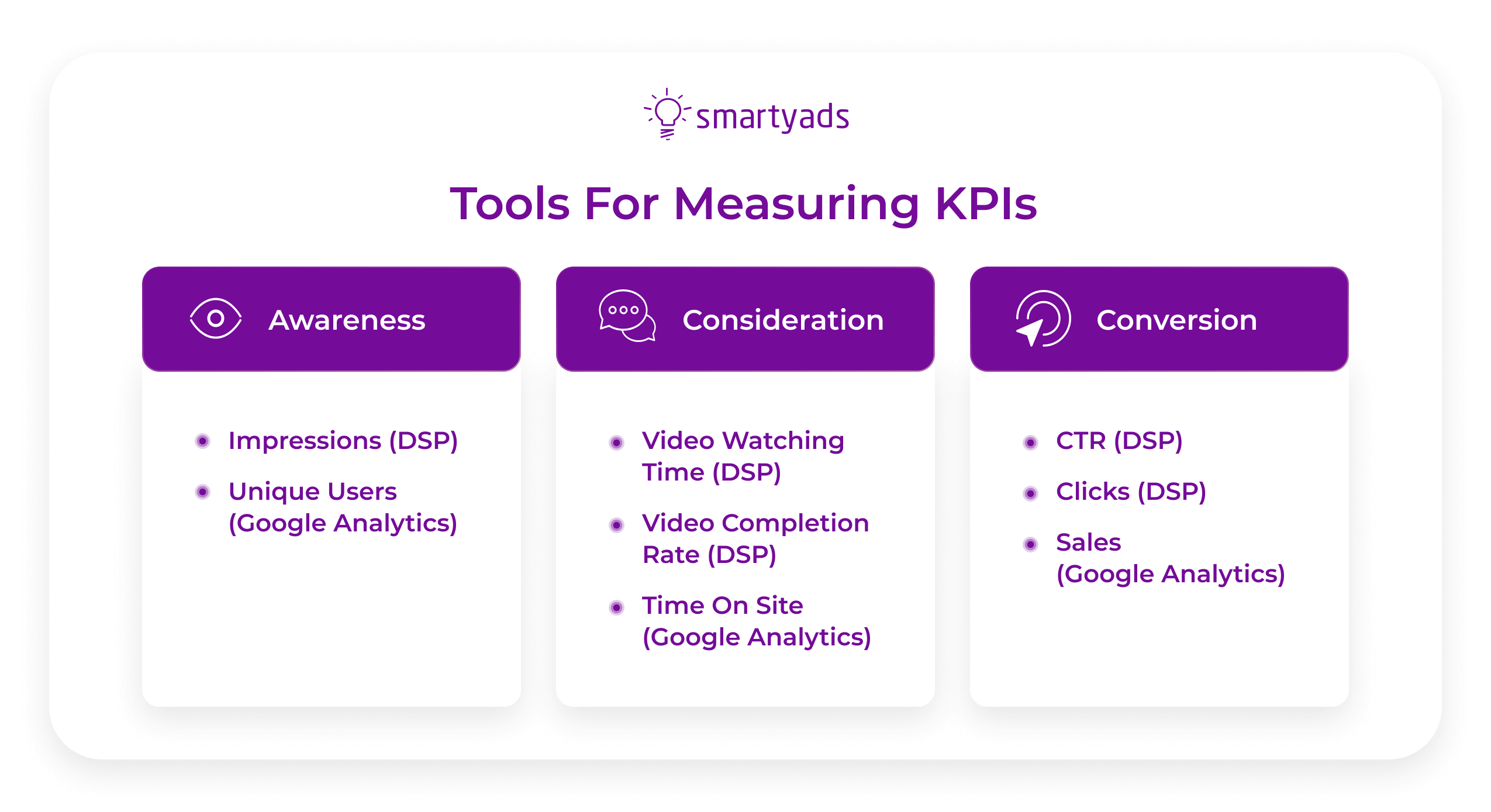
Refine and Optimize
Continuously monitor the performance of your brand awareness campaigns and optimize based on the insights gained. Make data-driven decisions to improve targeting, messaging, creative, and media placements for maximum impact.
To wrap it up
In conclusion, measuring brand awareness is a crucial aspect of any marketing strategy, allowing businesses to gauge their brand's visibility, reach, and impact on the target audience. By utilizing various techniques to measure brand awareness and leveraging tools such as DSPs, marketers can track key metrics like impressions, reach, frequency, and engagement and conduct brand lift studies to gain valuable insights into the effectiveness of their campaigns.
Remember, measuring brand awareness is an ongoing process that requires continuous monitoring and refinement to stay attuned to ever-changing preferences.
Raise and measure your brand awareness with SmartyAds DSP!
